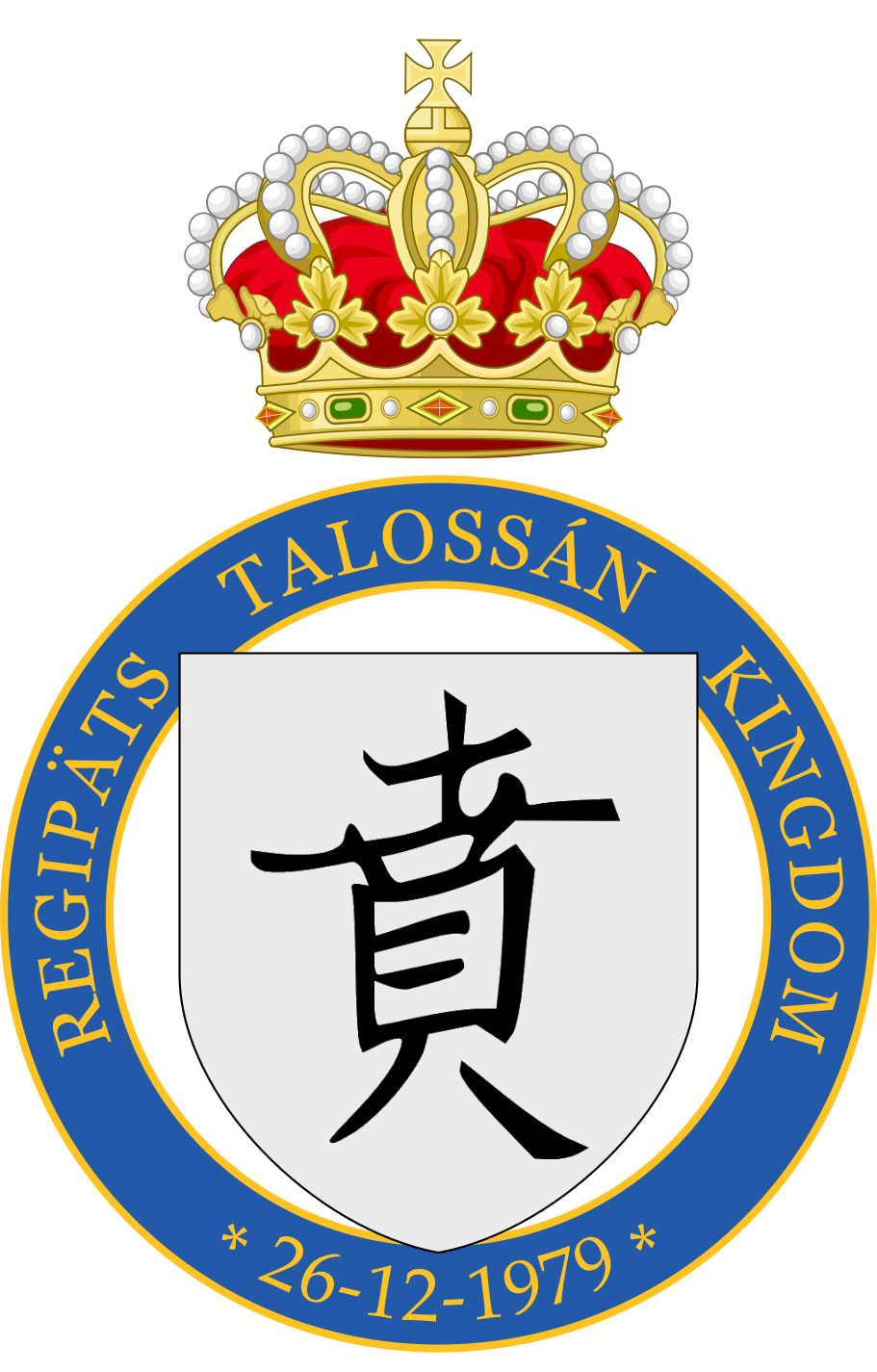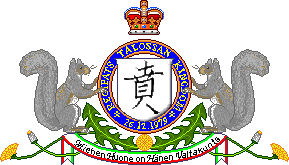Symbols: Difference between revisions
m (→"Ben" symbol) |
mNo edit summary |
||
| Line 7: | Line 7: | ||
==Coat of Arms== | ==Coat of Arms== | ||
[[Image:Arms.png|thumb|100px|left|Arms of the State]]The current coat of arms of [[Talossa]], as maintained and described by the [[Royal College of Arms]], is an image of a shield with the Chinese symbol for "Ben, | {{main|National Coat of Arms}} | ||
[[Image:Arms.png|thumb|100px|left|Arms of the State]]The current coat of arms of [[Talossa]], as maintained and described by the [[Royal College of Arms]], is an image of a shield with [[the Chinese symbol for "Ben}]], surrounded by a circle inscribed with the date of the founding of the nation and topped by a crown. Formally, it is "argent the Chinese character 'Ben' sable," mantled by "an annulet azure fimbriated or bearing the words 'Regipäts Talossán Kingdom * 26.12.1979 *' Or," and topped with "a royal crown proper." | |||
==Greater State Seal== | |||
[[Image:Talarms.gif|thumb|150px|right|Greater Arms of the State]]The Greater State Arms is slightly more grand: the coat of arms is also supported by two squirrels standing on a ribbon bearing the national motto of "A Man's Room Is His Kingdom," in Finnish. It is formally described as "two Talossan squirrels proper standing upon a ribbon argent fimbriated at the chief vert and at the base gules bearing the motto ''Miehen Huone on Hänen Valtakuntansa'' ('A Man's Room Is His Kingdom')" | [[Image:Talarms.gif|thumb|150px|right|Greater Arms of the State]]The Greater State Arms is slightly more grand: the coat of arms is also supported by two squirrels standing on a ribbon bearing the national motto of "A Man's Room Is His Kingdom," in Finnish. It is formally described as "two Talossan squirrels proper standing upon a ribbon argent fimbriated at the chief vert and at the base gules bearing the motto ''Miehen Huone on Hänen Valtakuntansa'' ('A Man's Room Is His Kingdom')" | ||
[[Category:History]] | [[Category:History]] | ||
Revision as of 17:01, 10 August 2012
Talossa has had numerous national symbols since the first day of its founding. These include, most prominently, the national flag and the national coat of arms.
Flag
That national flag, or the bicoloreu, consists of a green field over a red field (formally described as ("Per fess vert and gules"). The green in the flag symbolises the monarchy and its magnanimity, while the the red stands for the people and their tenacity.
The flag was adopted on March 2nd, 1981/II. Initially, it also possessed a white stripe, but this was considered to be too similar to other sorts of flags, and abandoned.
Coat of Arms
- See our main article on this subject at National Coat of Arms.
- See our main article on this subject at National Coat of Arms.
The current coat of arms of Talossa, as maintained and described by the Royal College of Arms, is an image of a shield with [[the Chinese symbol for "Ben}]], surrounded by a circle inscribed with the date of the founding of the nation and topped by a crown. Formally, it is "argent the Chinese character 'Ben' sable," mantled by "an annulet azure fimbriated or bearing the words 'Regipäts Talossán Kingdom * 26.12.1979 *' Or," and topped with "a royal crown proper."
Greater State Seal
The Greater State Arms is slightly more grand: the coat of arms is also supported by two squirrels standing on a ribbon bearing the national motto of "A Man's Room Is His Kingdom," in Finnish. It is formally described as "two Talossan squirrels proper standing upon a ribbon argent fimbriated at the chief vert and at the base gules bearing the motto Miehen Huone on Hänen Valtakuntansa ('A Man's Room Is His Kingdom')"


